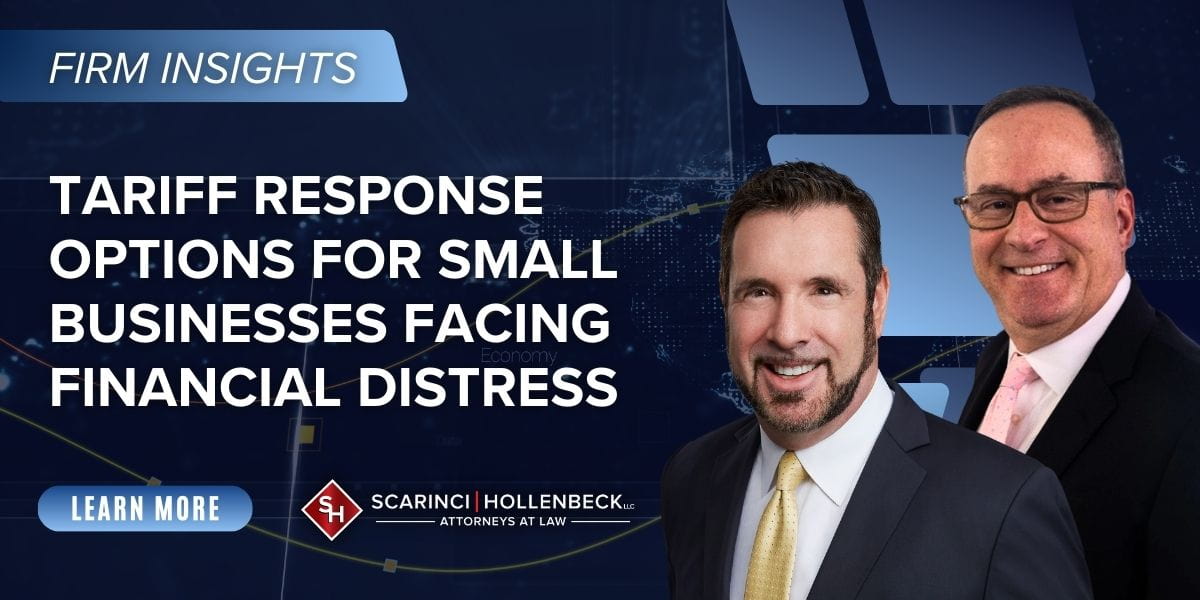
Brian D. Spector
Partner
201-896-7206 bspector@sh-law.comFirm Insights
Authors: Brian D. Spector, David Edelberg
Date: May 9, 2025

Partner
201-896-7206 bspector@sh-law.com
Partner
201-896-7701 dedelberg@sh-law.com
The Trump Administration’s new tariffs are having an oversized impact on small businesses, which already tend to operate on razor thin margins. Many businesses have been forced to raise prices, find new suppliers, lay off staff, and delay growth plans. For businesses facing even more dire financial circumstances, there are additional tariff response options, including workouts, reorganizations, and liquidations.
In basic terms, a tariff is a tax imposed on imported goods. Tariffs can serve a number of strategic goals, which include bolstering U.S. manufacturing and encouraging fair trade. Since taking office in January, President Donald Trump has increased tariffs on the import of many foreign goods, including those from China, Mexico, and Canada. The burden of these new tariffs is being felt across industries. It is also impacting businesses of all sizes that rely on overseas suppliers or imported goods.
For small businesses facing higher costs, disrupted supply chains, and slimmer margins due to the new import taxes, it is imperative to explore all of your options. Below are a few ways to ease growing tariff burdens:
Small businesses should start by reviewing their financials to identify areas to cut costs. Costs savings may also be achieved by streamlining and optimizing your operations through automation, analytics, and other technology.
Now is also the time to look for alternative suppliers, both domestically and abroad. Small businesses should also explore the possibility of negotiating more favorable terms with existing suppliers.
Many small businesses must raise prices to maintain their margins. Gradual adjustments associated with added value, like improved customer service or loyalty perks, can help maintain customer loyalty. Being transparent about why the price increases are needed, i.e. higher tariffs, can also lessen the impact.
Going forward, small businesses may want to consider including contract provisions that address the impact of tariffs, such as price adjustment provisions or termination rights that are triggered when tariffs reach a certain level.
Small businesses should explore opportunities to obtain more favorable financing terms, such as a lower interest rate, extension on payment periods, or even temporary forbearance, through refinancing and other means. Some businesses may also benefit from debt factoring or invoice discounting.
For small businesses in significant financial distress due to higher tariffs, there are additional options. Signs that you need to consider more drastic measures include declining revenue, cash flow issues, missed loan payments, and mounting payables.
Loan workouts give businesses flexibility to continue operations. They help companies restructure and return to profitability. This makes them often the first option when facing financial distress.
A commercial loan workout is a negotiated agreement. It happens between a borrower and lender. The agreement restructures or modifies existing loan terms. The goal is avoiding a default.
Workouts benefit both businesses and lenders. Borrowers can remain operational and reestablish financial stability. Lenders preserve a way to recover debt.
Businesses must demonstrate commitment when negotiating a workout plan. They need to show they’ll fulfill their obligations. The plan must include concrete steps. These steps focus on reducing costs, increasing revenue, and improving profitability.
Workout plan terms vary. They depend on the original loan terms and the debtor’s circumstances. Below are a few common examples:
The Small Business Reorganization Act (SBRA), also referred to as Subchapter V, established a valuable tool for small businesses in financial distress. Established in 2020, Subchapter V is designed to serve as a streamlined bankruptcy process for small businesses.
Under the SBRA, small businesses with significant debt can reorganize and remain operational, while avoiding the more costly requirements of a Chapter 11 bankruptcy. A committee of creditors will not be appointed unless ordered by the court for cause. The debtor will generally not be required to prepare a disclosure statement, and more important, only the debtor can file a plan of reorganization. These features of a Subchapter V reorganization allow the process to proceed more quickly and prevent contested hearings that increase costs.
The SBRA also relaxes the requirements to confirm a plan. It eliminates the “absolute priority” rule, which requires that a Chapter 11 Plan be approved by all classes of creditors in order for business owners to retain their ownership interest. In a Subchapter V reorganization, equity owners can retain their ownership so long as the plan does not “discriminate unfairly” and is “fair and equitable.” It is also easier for the debtor to confirm a plan over creditors’ objections. Essentially, a plan will be confirmed so long as it provides that all of the debtor’s projected disposable income for three to five years will be used to make plan payments. Disposable income is defined as income that is available after the payment of ongoing business expenses.
To take advantage of a Subchapter V reorganization, small businesses must meet certain eligibility criteria. Most notably, debtors cannot have debt in excess of $3,024,725. Additionally, the debt must be at least 50% comprised of commercial or business debt.
Liquidation involves converting assets into cash to satisfy creditors. Because it results in the closure of the business, it is generally considered a last resort. In a voluntary liquidation, the owners of the business (partners, LLC members, shareholders, etc.) decide that it should be placed into liquidation. Meanwhile, a creditors’ liquidation results from a creditor petitioning the court to wind up the business because it is balance sheet insolvent or unable to pay its debts when due.
Liquidation generally involves a formal legal process in which a liquidator is appointed to sell off assets, pay creditors, and distribute any remaining funds. Once the liquidation process is complete, the company ceases to exist as a legal entity. This is different from bankruptcy, where a business may be restructured or liquidated.
Scarinci Hollenbeck, LLC is here to help small businesses navigate the financial challenges posed by the recent increase in tariffs. Whether your business needs assistance renegotiating a supplier contract, devising a workout plan, or reorganizing, Scarinci Hollenbeck, LLC has the right legal team, including members of the Bankruptcy & Creditors’ Rights, Corporate Transactions & Business, and Litigation practices.
Results may vary depending on your particular facts and legal circumstances.
No aspect of this advertisement has been approved by the Supreme Court.
No Aspect of the advertisement has been approved by the Supreme Court. Results may vary depending on your particular facts and legal circumstances.

When done successfully, industry roll-up acquisitions can dramatically grow and strengthen your business. In this post, we break down what an industry roll-up is, why companies pursue it, and what makes it an effective (and sometimes risky) business strategy. What Is an Industry Roll-Up Acquisition? In an industry roll-up acquisition of companies, a buyer acquires multiple companies […]
Author: Dan Brecher

The federal government has launched one of the most ambitious scientific initiatives in decades, and it will redefine how companies develop technology, manage risk, and compete. The Genesis Mission, created by Executive Order and driven by the Department of Energy (“DOE”), is intended to accelerate scientific discovery through a national AI platform that links supercomputers, […]
Author: Michael J. Sheppeard

Stablecoins Leave the Grey Zone Stablecoins were supposed to be the “boring” part of crypto: digital dollars that just work. Yet for years they have lived in a regulatory no-man’s-land, classified one day as securities, the next as commodities, and sometimes as something regulators had not even named yet. That uncertainty is finally starting to […]
Author: Bryce S. Robins

If you operate a business without the proper license, you risk fines, insurance issues, reputational harm, and even business closure. Even innocent mistakes, like forgetting to renew a license, can have significant consequences, such as losing your lawsuit for payment of services that are unlicensed, which makes it imperative to have business license management procedures […]
Author: Dan Brecher

What Developers Need to Know About New Jersey’s Rent Control Exemption Law to Ensure Entitlement to Exemption for Newly Constructed Multi-family Housing. A property owner in Jersey City is facing a $400 million federal class action lawsuit alleging that the landlord did not follow the procedural steps required to be eligible for exemption from local […]
Author: Patrick T. Conlon

The application of traditional federal securities laws to crypto assets continues to evolve. In some cases, the Securities and Exchange Commission (SEC) considers tokens and other digital assets to be securities. This makes them subject to federal securities law, including the Securities Act of 1933 and the Securities Exchange Act of 1934. This classification has […]
Author: Bryce S. Robins
No Aspect of the advertisement has been approved by the Supreme Court. Results may vary depending on your particular facts and legal circumstances.
Consider subscribing to our Firm Insights mailing list by clicking the button below so you can keep up to date with the firm`s latest articles covering various legal topics.
Stay informed and inspired with the latest updates, insights, and events from Scarinci Hollenbeck. Our resource library provides valuable content across a range of categories to keep you connected and ahead of the curve.
Let`s get in touch!
Sign up to get the latest from the Scarinci Hollenbeck, LLC attorneys!